Russia Will Help Syria Restore Palmyra Museum Artifacts Damaged by ISIS with AKF 2019-11-28
In a strategic move this week, the state Hermitage Museum announced that Russia has partnered with Syria to restore 20 cultural artifacts from the National Museum of Palmyra that ISIS attempted to destroy over the last four years. A coalition will also look at rebuilding the historic sites of Palmyra damaged or destroyed by ISIS forces.
A group consisting of UNESCO, Russian experts, the Aga Khan Foundation and conservators from the National Museum of Oman will work with the Hermitage on the restoration. Hundreds of cultural sites in Syria have been damaged by ISIS, noted a 2014 U.N. report, among the many devastating tolls in war-torn Syria.
In 2015, ISIS blew up the Arch of Triumph, one of the jewels in the architectural crown of Roman-era buildings in Palmyra.
Wikipedia
The Trump administration formally withdrew the U.S. from UNESCO, the United Nations' cultural and scientific organization, in 2019.
The Hermitage statement reads, in part:
On 25 November 2019, in the Syrian Directorate-General for Antiquities and Museums, agreements were signed on collaboration between the Directorate-General and the Hermitage and the Directorate-General and the Saint Petersburg-based Institute of Material Culture. Both agreements are a tangible step in the significant development of museum and research relations between Russia and Syria.
In their specifics, these agreements are aimed at producing a master plan for the regeneration of the Palmyra Museum as a basis for the creation of an innovative 21st-century museum-preserve on the historical territory of the site and they envisage:
The creation of a 3D geo-information system of the Palmyra archaeological site for use in the museum and tourist centre of Palmyra (the system has been created and passed on to the Directorate-General for Antiquities and UNESCO)
the creation of a set of architectural reconstructions of the original appearance of Palmyra’s architectural monuments (created by Maxim Atayants’s studio and passed on to the Directorate-General for Antiquities and UNESCO)
providing working visits to the Hermitage for Syrian specialists for the exchange of experience in the restoration of Palmyran artefacts, the preparation of exhibitions and publications devoted to Palmyra, and discussion of the future concept for the Palmyra museum
Working visits by Syrian archaeologists to Hermitage and IMC expeditions in the field with the aim of preparing for the restoration of the Palmyra Museum.
In the longer term, the development of this agreement envisages:
joint work by the Hermitage and the National Museum of Oman to restore 20 Syrian artefacts, mainly from Palmyra, as a step towards preparing the display of the Palmyra Museum
stimulation of an international campaign for the regeneration of Palmyra
the creation and international discussion of a project for an innovative Museum and Museum-Preserve at Palmyra
the formation of an international initiative expert group under the direction of UNESCO and the Syrian Directorate-General for Antiquities and Museums with the participation of the Hermitage and the Aga Khan Foundation
expert support from the Hermitage for projects to develop Palmyra-Tadmur, the Citadel of Damascus and the historical buildings of Aleppo.
On the same day, the exhibition “Two Palmyras” was formally opened at the National Museum in Damascus in the presence of Russian Ambassador Alexander Yefimov. Mikhail Piotrovsky gave a lecture on “The Greater Hermitage in the Northern Palmyra. The 21st Century”.
An official meeting between the Russian delegation and the Syrian Minister of Culture, Mohammad al-Ahmad, was devoted to the development of the agreement. The delegation also participated in the opening of the Days of Syrian Culture in Damascus.
- 1677 reads
 Ismaili.NET - Heritage F.I.E.L.D.
Ismaili.NET - Heritage F.I.E.L.D.